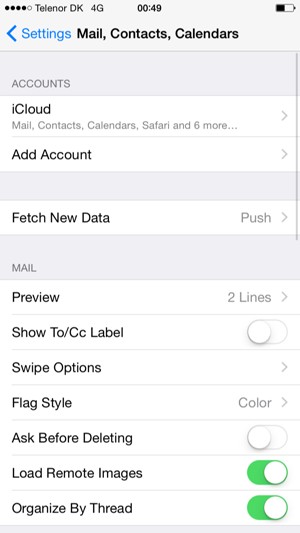

The option to load remote images is enabled in Mail by default, but you can turn it off.Īs you might have guessed by now, that toggle is in the Settings app, inside the Mail section. We’re not talking about pictures people have attached in their emails to you. And do note here that by remote images, we’re talking about images that are inline URLs within a message that point to pictures online (just like in a web page). Pictures can also eat up bandwidth if you get a lot of them. Spam senders can use tiny embedded images to determine whether you’ve opened a message (and thereby verified that your email address is legitimate). Review your email provider’s POP settings and use them to set the correct Server Port or turn on SSL, if it’s required. This means you can receive emails on your iPhone, but doing so doesn’t delete them from the server. Tap ‘Delete from server’ and choose ‘Never.’.

Loading remote images in your email is part security concern and part bandwidth concern. Scroll to the bottom and tap ‘Advanced.’. Select the action you want each gesture to take by tapping on either the “Swipe Left” or “Swipe Right” options. The resulting screen shows two options: one for when you swipe to the left and one for when you swipe to the right. Tap the “Preview” option in the “Message List” section. Head into Settings and then tap the “Mail” option. Shorter previews let you see more messages on the screen at once. Longer previews let you see what messages are about without opening them. If you receive a lot of emails, you may also want to control how much of a message you see as a preview within the Mail app. You can choose whether to see icon badges, notifications on the Lock screen, and hear alert sounds when an email arrives. Make sure that the “Allow Notifications” switch is turned on (if you want notifications), and then choose how you would like notifications to arrive. Open Settings and tap “Notifications” to see a list of the installed apps that support notifications. You manage all iPhone and iPad notifications in the Settings app, and push notifications are no different. Your information will be verified, and if the credentials are correct, your email will be configured. Type in your credentials on the New Account screen and tap Next. These will differ depending on the type of account involved but are all self-explanatory along the way. Tap Settings on the Home Screen of your iPhone. Tap the type of account you need to add and follow the authentication prompts. You'll then be brought to your Android's Server Settings screen, where you can access your server information.You’ll then see a list of popular account types, as well as an “Other” option for anyone with a specialized setup.Select your email address, and under Advanced Settings, click Server Settings.Navigate to your Android's Settings, and then click Apps.This will display your incoming (IMAP) and outgoing (SMTP) mail server information to use in HubSpot.Select the email account you want to connect to HubSpot.On the next screen, click Mail, then select Accounts.To find the ports for each server, click More settings. > Advanced.Below Server Information, you can find your incoming mail server (IMAP) and outgoing mail server (SMTP) names.On the Email tab, double-click on the account you want to connect to HubSpot.

Then navigate to Account Settings > Account Settings. The longer text box is the server name and the text box towards the right is the port. Use this information when setting up your connected inbox in HubSpot. Find the fields for Incoming server and Outgoing server.In the left sidebar, click on the account you want to connect to HubSpot.Select Preferences, then click Accounts.You may need to use the dropdown menu to select Edit SMTP server list to view the SMTP server name. Next, find the field for Outgoing Mail Server.Find the field for Incoming Mail Server.In the left sidebar, select the account you want to connect to HubSpot.Click Mail in your Mac's toolbar, then select Preferences from the dropdown menu.If not, you can take the steps below to find them in your email client: Your IT team should be able to provide your mail server's IMAP and SMTP information. It is sometimes necessary to add more details in the Advanced Options section when connecting your inbox to HubSpot using IMAP.


 0 kommentar(er)
0 kommentar(er)
